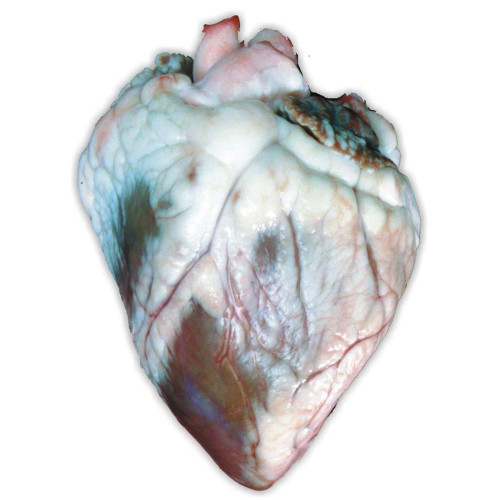DESCRIPTION
Many mammal hearts are similar to that of a human heart, which makes this dissection specimen great for studying both internal and external anatomy of the heart.
This mammal heart specimen will typically be from sheep; however, a pig or goat heart may be substituted due to limited availability of sheep hearts.
With a scalpel in hand, elementary, middle, and high school students can learn so much about a mammal heart's internal anatomy. They'll discover the placements of parts such as the:
- right atrium & left atrium,
- right ventricle & left ventricle,
- aortic semilunar valve, bicuspid valve & tricuspid valve,
- interventricular spectrum,
- aorta,
- chordae tendineae,
- pulmonary vein, pulmonary artery & pulmonary trunk,
- papillary muscles,
- inferior vena cava,
- blood vessels,
- and more!
Heart dissection reveals the intricacies required of a heart to pump blood. This hands-on experience shows students the differences between and roles of the right side of the heart and the left side of the heart in a memorable way.
Note: Preserved mammal heart specimens are initially treated with a formaldehyde solution, the best animal tissue fixative. The formaldehyde is then displaced, first with water and then with a glycol solution, to produce a moist, low-fume specimen which will not decay over time.
Important Notice: For orders of 10 or more, there is a chance these specimens could be shipped in a 10-pack. If you require specimens to be individually packaged, please contact our customer service at (406) 256-0990.
HST Specimen Guarantee
In sealed, original packaging, our preserved specimens are guaranteed to remain fully preserved and free of decay for 12 months from the date of purchase.
Once the original package is opened, use specimen within one month. For best results, observe the following storage procedures:
- Store specimen in heavy-duty, zip-lock bags to minimize drying between dissections.
- Specimen will slowly dry out or become contaminated in zip-lock bags; add a teaspoon of Specimen Holding Fluid to retain moisture.
- Freezing or refrigeration is not necessary and may damage fragile tissues.
MORE INFORMATION BOX
CONTENTS TAB
SPECIFICATIONS TAB
 Warning
Warning

